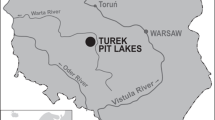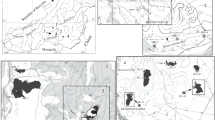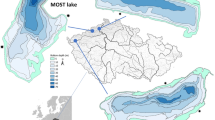Abstract
Acidic mining lakes (ML) in Lusatia (Germany) are characterised by their geogenically determined chemistry. The present study describes the structure, main components and relationships within the food webs of three acidic mining lakes with different pH values (ML 111: pH 2.6; ML 117: pH 2.8; ML Felix: pH 3.6) in order to show their typical characteristics. The investigation covered the period 1995–1997. The number of species and the biomass are both low, but increase with increasing pH. Planktonic components in the most acidic ML 111 (pH 2.6–2.9) comprise bacteria, Ochromonas spp. and Chlamydomonas spp. and a few rotifers (E. worallii, C. hoodi). Heliozoans are the top-predators. In ML 117 (pH 2.8–3) Gymnodinium sp., ciliates, the rotifer B. sericus and the pioneer crustacean Chydorus sphaericus join the pelagial community. Heliozoans were not found in ML 117 or ML Felix (pH 3.4–3.8). ML Felix had the most taxa. The benthic food chain of all three lakes includes phytobenthic algae as producers, chironomids as primary consumers and corixids as top predators in the profundal. Corixids predate on small cladocerans inhabiting the pelagial in lakes with a pH above 2.8 such as ML Felix. They invade the pelagial and act as a connecting link between the benthic and the pelagic food chains, which are isolated in lakes with a lower pH. Occasionally primary producers and consumers were abundant in all three lakes. These organisms do not depend on the degree of acidity, but on the availability of essential ressources. Mass variations covered up any seasonal variation in the extremely acidic ML 111 (0.9 mm3 l−1), while in the other two lakes seasonal patterns of biomass were found.
Similar content being viewed by others
References
Almer, B., W. Dickson, C. Ekström, E. Hörnström & U. Miller, 1974. Effects of acidification on Swedish lakes. Ambio 3: 30–36.
Almer, B., W. Dickson, C. Ekström & E. Hörnström, 1978. Sulfur pollution and the aquatic ecosystem. In Nriagu, J. O. (ed.), Sulfur in the Environment (Part 2). Ecological Impacts, New York: 271-311.
Arvola, L., K. Salonen, P. Kankaala & A. Lehtovaara, 1992. Vertical distributions of bacteria and algae in a steeply stratified humic lake under high grazing pressure from Daphnia longispina. Hydrobiologia 229: 253–269.
Bittl, T. & H.-D. Babenzien, 1996. Heterotrophe Aktivität des Bakterioplanktons in einem sauren Gewässer. Dt. Ges. f. Limnol. Erw. Zus. d. Jahrestagung 1995 in Berlin 2: 918–922.
Blouin, A. C., 1989. Patterns of plankton species, pH and associated water chemistry in Nova Scotia lakes. Wat. Air Soil Pollut. 46: 343–358.
Brett, M. T., 1989. The distribution of free swimming macroinvertebrates in acidic lakes of Maine: the role of fish predation. Aquat. Fenn. 19: 113–118.
Brakke, D. F., J. P. Baker, J. Böhmer, A. Hartmann, M. Havas, A. Jenkins, C. Kelly, S. J. Ormerod, T. Paces, R. Putz, B. O. Rosseland, D. W. Schindler & H. Segner, 1992. Group Report: Physiological and ecological effects of acidification on aquatic biota. In Steinberg, C. E. W. & R. F. Wright (eds), Acidification of Freshwater Ecosystems. Implications for the Future. John Wiley & Sons, Chichester: 275–312.
Deneke, R., 2000. Review of rotifers and crustaceans in highly acidic environments of pH values ?3. Hydrobiologia 433: 167–172.
Engelmann, H.-D., 1973. Eine Lichtfalle für den Insektenfang unter Wasser. Entom. Abh.Mus. Tierk. 39: 224–226.
Evans, R. A., 1989. Response of limnetic insect populations of two acidic, fishless lakes to liming and Brook trout (Salvelinus fontinalis). Can. J. Fish. aquat. Sci. 46: 342–351.
Geller, W., H. Klapper & M. Schultze, 1998. Natural and anthropogenic sulfuric acidification of lakes. In Geller, W., H. Klapper & W. Salomons (eds), Acidic Mining Lakes. Springer Verlag, Berlin, Heidelberg: 3–14.
Goldman, J. C., W. J. Oswald & D. Jenkins, 1974. The kinetics of inorganic carbon limited algal growth. Journal WPCF 46: 554–574.
Gyure, R. A., A. Konopka, A. Brooks & W. Doemel, 1987. Algal and bacterial activities in acidic (pH 3) strip mine lakes. Appl. environ. Microbiol. 53: 2069–2076.
Heins, A., 1993. Zur ökologischen Bedeutung der Corixiden (Hemiptera, Heteroptera) im Pelagial der 'Großen Fuchskuhle', mit Anmerkungen zu Chaoborus (Diptera, Chaoboridae). Diplomarbeit, FU Berlin: 55 pp.
Henrikson, L. & H. G. Oscarson, 1981. Corixids (Hemiptera-Heteroptera), the new top-predators in acidified lakes. Verh. int. Ver. Limnol. 21: 1616–1620.
Henrikson, L. & H. G. Oscarson, 1984. Lime influence on macroinvertebrate zooplankton predators. Rep. Inst. Freshwater Res. Drottningholm 61: 93–103.
Henrikson, L. & H. G. Oscarson, 1985. Waterbugs (Corixidae, Hemiptera-Heteroptera) in acidified lakes, habitat selection and adaptations. Ecol. Bull. 37: 232–238.
Klapper, H. & M. Schultze, 1995. Geogenically acidified Mining lakes-living conditions and possibilities of restoration. Int. Rev. ges. Hydrobiol. 80: 639–653.
Kwiatowski, R. E. & J. C. Roff, 1976. Effects of acidity on the phytoplankton and primary productivity of selected northern Ontario lakes. Can. J. Bot. 54: 2546–2561.
Laliberté, G. & J. de la Noüe, 1993. Auto-, hetero-and mixotrophic growth of Chlamydomonas humicola (Chlorophyceae) on acetate. J. Phycol. 29: 612–620.
Lessmann, D. & B. Nixdorf, 1997. Charakterisierung und Klassifizierung von Tagebauseen der Lausitz anhand morphometrischer Kriterien, physikalisch-chemischer Parameter und der Phytoplanktonbesiedlung. In Deneke, R. & B. Nixdorf (eds), Gewässerreport (Teil III). BTUC-AR 5/97: 9-18.
Locke, A., 1992. Factors influencing community structure along stress gradients: zooplankton responses to acidification. Ecology 73: 903–909.
McConathy, J. R. & J. B. Stahl, 1982. Rotifera in the plankton and among filamentous algal clumps in 16 acid strip mine lakes. Trans. III Acad. Sci. 75: 85–90.
Mischke, U., M. Kapfer & H. Krumbeck, 1997. Wachstums-und photosynthetisch limitierende Faktoren in extrem sauren Tagebaurestseen. Dt. Ges. f. Limnol. Erw. Zus. d. Jahrestagung 1996 in Frankfurt/M: 508-512.
Morling, G. & B. Peljer, 1990. Acidification and zooplankton variation in some West-Swedish lakes 1966-1983. Limnologica 20: 307–318.
Nixdorf, B. & S. Hoeg, 1993. Phytoplankton community structure, succession and chlorophyll content in LakeMüggelsee from 1979 to 1990. Int. Rev. ges. Hydrobiol. 78: 359–377.
Nixdorf, B. & M. Kapfer, 1998. Stimulation of phototrophic pelagic and benthic metabolism close to sediments in acidic mining lakes. Wat. Air Soil Pollut. 108: 317–330.
Nixdorf, B., U. Mischke & D. Lessmann, 1998 a. Chrysophytes and chlamydomonads: Pioneer colonists in extremely acidic mining lakes (pH < 3) in Lusatia (Germany). Hydrobiologia 369/370 (Dev. Hydrobiol. 129): 315–327.
Nixdorf, B., K. Wollmann & R. Deneke, 1998 b. Ecological potentials for planktonic variation and food web interactions in extremly acidic mining lakes in Lusatia. In Geller, W., H. Klapper & W. Salomons (eds), Acidic Mining Lakes. Springer Verlag, Berlin, Heidelberg: 147–167.
Nyman, H. G., H. G. Oscarson & J. A. E. Stenson, 1985. Impact of invertebrate predators on the zooplankton composition in acid forest lakes. Ecol. Bull. 37: 239–243.
Olaveson, M. M. & C. Nalewajko, 1994. Acid rain and freshwater algae. Arch. Hydrobiol. Beih. 42: 99–123.
Packroff, G., 2000. Protozooplankton in acidic mining lakes with special respect to ciliates. Hydrobiologia 433: 157–166.
Page, C. & F. J. Siemensma, 1991. Nackte Rhizopoda und Heliozoa. Gustav Fischer Verlag, Stuttgart, New York: 297 pp.
Porter, K. G. & Y. S. Feig, 1980. The use of DAPI for identifying and counting aquatic microflora. Limnol. Oceanogr. 25: 943–948.
Scharf, B., 1998. In BTUC (1998): BMBF-Verbundvorhaben LENAB: Leitbilder für naturnahe Bereiche. Brandenburgische Technische Universität Cottbus. Abschlußbericht: Gesamtbericht (88 S.) und Teilprojekt 3 (110 S.)
Schmidt-Halewicz, S., 1996. Konsequenzen der Gewässerversauerung für das mikrobielle Nahrungsnetz im See. Dt. Ges. f. Limnol. Erw. Zus. d. Jahrestagung 1995 in Berlin: 938-944.
Schindler, D. W., 1990. Experimental perturbations of whole lakes as tests of hypotheses concerning ecosystem structure and function. Oikos 57: 25–41.
Schindler, D. W. & S. K. Holmgren, 1971. Primary production and phytoplankton in the Experimental Lakes Area, northwestern Ontario, and other low carbonate waters, and a liquid scintillation method for determining 14C activity in photosynthesis. J. Fish. Res. Bd Can. 28: 189–201.
Utermöhl, H., 1958. Zur Vervollkommnung der quantitativen Phytoplanktonmethodik. Mitt. int. Ver. Limnol. 9: 1–38.
Vangenechten, J. H. D., S. Van Puymroeck & O. L. J. Vanderborght, 1979. Effects of pH on the uptake of sodium in the waterbugs Corixa dentipes (Thoms.) and Corixa punctata (Illig.) (Hemiptera, Heteroptera). Comp. Biochem. Physiol. 64: 509–521.
Winberg, G. G., 1971. Symbols, units and conversion factors in studies of freshwater productivity. London: IBP Control Office: 1–23.
Woelfl, S., in press. Limnology of sulfur acidic lignite mining lakes. Biological properties: Plankton structure of an extreme habitat. Verh. int. Ver. Limnol.
Woelfl, S., B. Zippel & G. Packroff, 1998. Planktongesellschaften der mitteldeutschen Tagebaurestseen. Dt. Ges. f. Limnol. Erw. Zus. d. Jahrestagung 1997 in Frankfurt/M: 376-380.
Wollmann, K., 1998: Zur Ökologie der Corixiden (Hemiptera, Heteroptera) in Tagebauseen der Lausitz. Dt. Ges. f. Limnol. Erw. Zus. d. Jahrestagung 1997 in Frankfurt/M: 535-539.
Wollmann, K., 2000. Corixidae (Hemiptera, Heteroptera) in acidic mining lakes with pH < 3 of Lusatia (Germany). Hydrobiologia 433: 181–183.
Yan, N. D., 1979. Phytoplankton community of an acidified, heavy metal-contaminated lake near Sudbury, Ontario: 1973-1977. Wat. Air Soil Pollut. 11: 43–55.
Rights and permissions
About this article
Cite this article
Wollmann, K., Deneke, R., Nixdorf, B. et al. Dynamics of planktonic food webs in three mining lakes across a pH gradient (pH 2–4). Hydrobiologia 433, 3–14 (2000). https://doi.org/10.1023/A:1004060732467
Issue Date:
DOI: https://doi.org/10.1023/A:1004060732467




